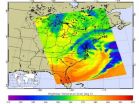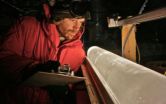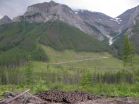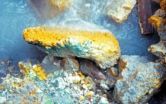(Press-News.org)
VIDEO:
This animation of NOAA GOES-13 satellite imagery from March 5-7, 2013, shows the progression of a cold front from the west associated with a low pressure system that brought snow...
Click here for more information.
The merging of two low pressure areas into a large Nor'easter on March 6 brought winter weather advisories and warnings to the Mid-Atlantic. NASA's Aqua satellite captured an infrared and near infrared image of the storm's power, and NASA created an animation of the storm's movement using NOAA's GOES-13 satellite imagery.
Infrared data from the Atmospheric Infrared Sounder (AIRS) instrument aboard NASA's Aqua satellite was made into a false-colored image of the Nor'easter from March 6 at 1817 UTC (1:17 p.m. EST). Infrared imagery shows temperature data. The coldest cloud tops indicate the highest storm clouds, and the strongest convection. The coldest cloud top temperatures were near -45 Fahrenheit ( -43 Celsius), and were areas with the heaviest precipitation. At the time of the image, the coastal low pressure area's heaviest precipitation stretched over New Jersey, southeastern Pennsylvania, most of Maryland, Delaware, and eastern and northeast and central Virginia. Other areas of very cold cloud tops and heavy precipitation appeared over the Atlantic in the storm's arm, east and south of the center of circulation.
An animation of NOAA GOES-13 satellite imagery over the days of March 5, 6 and early on March 7 was created by the NASA GOES Project at NASA's Goddard Space Flight Center in Greenbelt, Md. The 24 second animation showed the progression of a cold front from the west associated with a low pressure system that brought snow from Chicago to the Appalachian Mountains. The low merged with a coastal low near the Mid-Atlantic on March 6 and brought up to 2 feet of snow in the Blue Ridge Mountains, while coastal areas and cities including Washington, D.C. and Baltimore received snow followed by heavy rain. The animation ends at 1331 UTC (8:31 a.m. EST) on March 7, when the nor'easter was affecting New England.
According to NOAA's National Operational Hydrologic Remote Sensing Center (NOHRSC) in Chanhassen, Minnesota, who compile and provide interactive snowfall information, the snowfall totals ranged from 18 inches in western northern Virginia to two-tenths of an inch at Reagan National Airport, Washington, D.C.
After the cold front and associated low that swept in from the Upper Mid-west merged with the coastal low pressure area, the coastal low pressure area became the driver. It brought in warmer temperatures from the Atlantic Ocean where sea surface temperatures were in the 40s (Fahrenheit). The warmer air helped keep the precipitation as rainfall in a line from Baltimore and Washington, D.C. eastward. It was the higher elevations in the Mid-Atlantic that saw the most snow.
According to NOHRSC, the Blue Ridge Mountains received the most snow, totaling up to 2 feet. Dulles Airport, Virginia received 3 inches; Blue Mountain, Virginia received 17 inches and Front Royal, Virginia received 12 inches. In Maryland, the city of Westminster which lies west of Baltimore received 4.5 inches, while Columbia, located south of Baltimore, received 2 inches of snow.
The strong winds that accompanied the nor'easter did cause wind warnings and advisories. According to the Baltimore Sun newspaper the winds toppled a tractor trailer truck on Maryland's Bay Bridge that connects to Annapolis. The bridge was closed for four hours. The winds caused tree damage and power outages in Maryland and Delaware. In western northern Virginia and western Maryland winds coupled with heavy, wet snow took down trees and left thousands without power.
INFORMATION:
NASA provides satellite views of Nor'easter on March 7, 2013
2013-03-08
ELSE PRESS RELEASES FROM THIS DATE:
Pan-STARRS finds a 'lost' supernova
2013-03-08
The star Eta Carinae is ready to blow. 170 years ago, this 100-solar-mass object belched out several suns' worth of gas in an eruption that made it the second-brightest star after Sirius. That was just a precursor to the main event, since it will eventually go supernova.
Supernova explosions of massive stars are common in spiral galaxies like the Milky Way, where new stars are forming all the time. They are almost never seen in elliptical galaxies where star formation has nearly ceased. As a result, astronomers were surprised to find a young-looking supernova in an old ...
Earth is warmer today than during 70 to 80 percent of the past 11,300 years
2013-03-08
With data from 73 ice and sediment core monitoring sites around the world, scientists have reconstructed Earth's temperature history back to the end of the last Ice Age.
The analysis reveals that the planet today is warmer than it's been during 70 to 80 percent of the last 11,300 years.
Results of the study, by researchers at Oregon State University (OSU) and Harvard University, are published this week in a paper in the journal Science.
Lead paper author Shaun Marcott of OSU says that previous research on past global temperature change has largely focused on the ...
UTHealth research: Low incidence of venous insufficiency in MS
2013-03-08
HOUSTON – (March 7, 2013) – Results of a study using several imaging methods showed that CCSVI (chronic cerebrospinal venous insufficiency) occurs at a low rate in both people with multiple sclerosis (MS) and non-MS volunteers, contrary to some previous studies. The research by an interdisciplinary team at The University of Texas Health Science Center at Houston (UTHealth) was published in a recent early online edition of the Annals of Neurology.
"Our results in this phase of the study suggest that findings in the major veins that drain the brain consistent with CCSVI ...
'Climate-smart strategies' proposed for spectacular US-Canadian landscape
2013-03-08
A new report from the Wildlife Conservation Society Canada (WCS Canada) creates a conservation strategy that will promote wildlife resiliency in the Southern Canadian Rockies to the future impacts of climate change and road use. The report's "safe passages and safe havens" were informed in part by an assessment of six iconic species—bull trout, westslope cutthroat trout, grizzly bears, wolverines, mountain goats and bighorn sheep—five of which were ranked as highly vulnerable to projected changes.
Nestled between Glacier National Park in Montana and Banff National ...
How to thrive in battery acid and among toxic metals
2013-03-08
In the movie Alien, the title character is an extraterrestrial creature that can survive brutal heat and resist the effects of toxins.
In real life, organisms with similar traits exist, such as the "extremophile" red alga Galdieria sulphuraria.
In hot springs in Yellowstone National Park, Galdieria uses energy from the sun to produce sugars through photosynthesis.
In the darkness of old mineshafts in drainage as caustic as battery acid, it feeds on bacteria and survives high concentrations of arsenic and heavy metals.
How has a one-celled alga acquired such ...
Disease knowledge may advance faster with CRISPR gene probing tool
2013-03-08
Scientists at UC San Francisco have found a more precise way to turn off genes, a finding that will speed research discoveries and biotech advances and may eventually prove useful in reprogramming cells to regenerate organs and tissues.
The strategy borrows from the molecular toolbox of bacteria, using a protein employed by microbes to fight off viruses, according to the researchers, who describe the technique in the current issue of Cell.
Turning off genes is a major goal of treatments that target cancer and other diseases. In addition, the ability to turn genes off ...
Sing a new song: Computer scientists use music to lure students to STEM majors
2013-03-08
To students in Jennifer Burg's computer science classes, making music is the main objective. But her goal is to get them to understand how the underlying technology works – and to love it so much they decide on a science-based career path.
And that, Burg's study has shown, has helped Wake Forest University fulfill the national imperative to increase the number of majors in the STEM disciplines of science, technology, engineering and math.
The results of Burg's research, "Computer Science 'Big Ideas' Play Well in Digital Sound and Music," will be published during the ...
Outdoor heat increases risk of emergency respiratory hospitalization in elderly
2013-03-08
Outdoor heat is associated with a significantly increased risk of emergency hospitalization for respiratory disorders in the elderly, according to a large epidemiological study of more than 12.5 million Medicare beneficiaries.
"While outdoor heat has been shown to increase respiratory mortality, evidence on the relationship between heat and respiratory hospitalizations has been less consistent," said lead author G. Brooke Anderson, PhD, postdoctoral fellow in the Department of Biostatistics at the Johns Hopkins Bloomberg School of Public Health. "In the largest population ...
Celebrity endorsement encourages children to eat junk food
2013-03-08
A study by the University of Liverpool has found that celebrity endorsement of a food product encourages children to eat more of the endorsed product. It also found that children were prompted to eat more of the endorsed product when they saw the celebrity on TV in a different context.
Celebrity endorsement is an effective method of creating value, recognition and credibility for a brand, and celebrities are frequently used in television advertising to induce children to try foods. An example of this is former England international soccer player Gary Lineker, now principally ...
Massachusetts criminal cases under review after false testimony revealed
2013-03-08
Massachusetts criminal cases under review after false testimony revealed
Article provided by Stephen E. Dawley, P.C., Attorney at Law
Visit us at http://www.stephendawley.com
As many as 34,000 criminal cases may be up for review after the arrest of a crime lab chemist in Boston last year. The chemist -- who was employed by a Massachusetts crime lab for the past nine years -- was in charge of testing suspected drug substances seized during arrests throughout the state.
False testimony revealed
The female chemist served as an expert witness at thousands of trials ...




